Essential Kitten Training Fundamentals
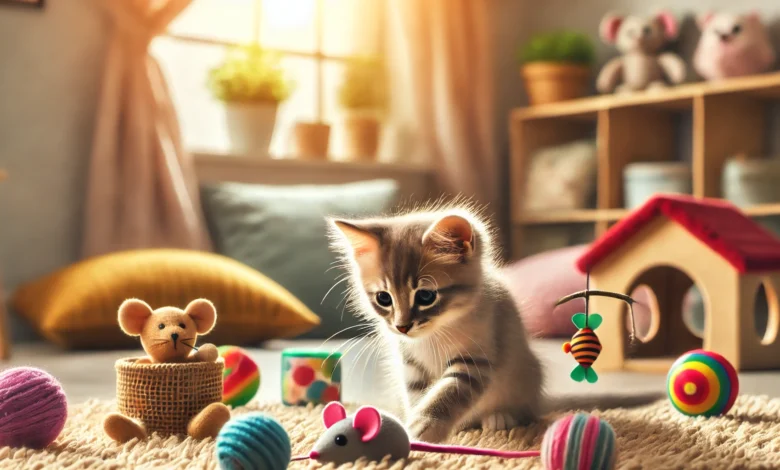
One of the best experiences for any owner is training a kitten.
Kittens are naturally curious, playful, and quick to learn, with their early stages in life considered very important in instilling good habits and behavior.
This lays the foundation for a well-behaved, happy, well-adjusted cat in the future by starting off early.
But why is it so crucial to train your kitten when she is still young?
This article will take you through the basics of kitten training and show you just how to maximize this period of your kitten’s life.
Table of Contents
Why Kitten Training is Important for Early Development
Training a kitten goes beyond merely giving commands; it also molds the future personality of your kitten to become confident, friendly, and manageable.
The first few months of a kitten’s life are crucial for learning and development.
It is during this period that they are most impressionable and open to new experiences.
Proper kitten training during these formative months helps ensure that your kitten becomes a well-adjusted adult cat.
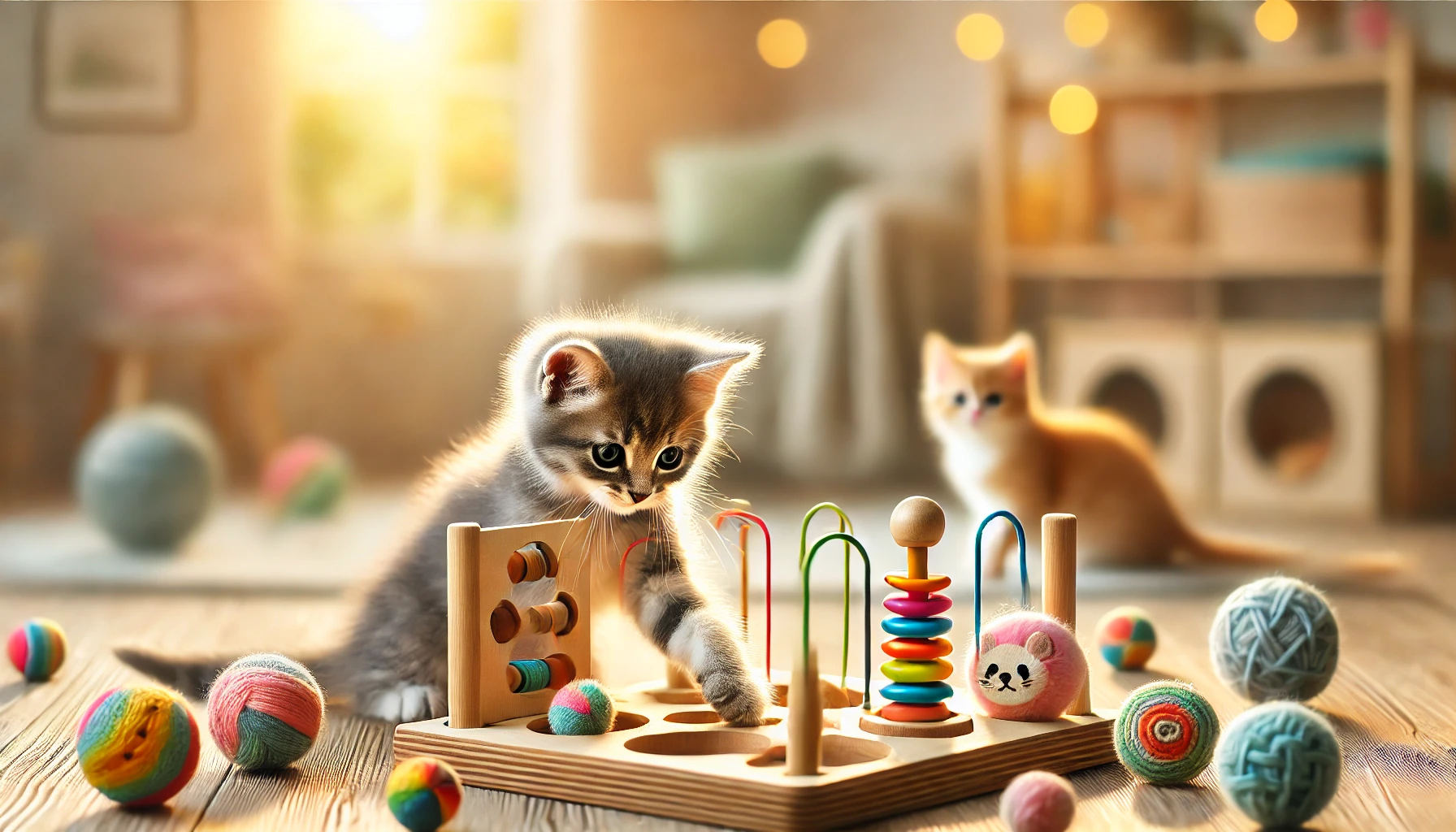
How a Kitten Learns
Kittens, like human babies, go through crucial periods of learning.
Kittens are most flexible, receptive to learning new things, and can easily learn until they are around 16 weeks of age.
This is widely known as the ‘socialization period.’ Through basic instinct, kittens will want to explore their surroundings, making this the best time for training.
- The first two weeks: This is the time when kittens are completely dependent on their mother and have just started developing their senses.
- Weeks 3-7: Kittens start showing independence and begin learning how to interact with their environment. This is the best time to start basic training.
- Weeks 8-16: During this time, kittens learn socializing behavior and how to respond to human signals. It’s essential to expose them to new people, animals, and environments to minimize future fear or aggression.
Knowing these stages will enable you to time your kitten training efforts to coincide with your kitten’s natural learning ability, making the process even easier and more effective.
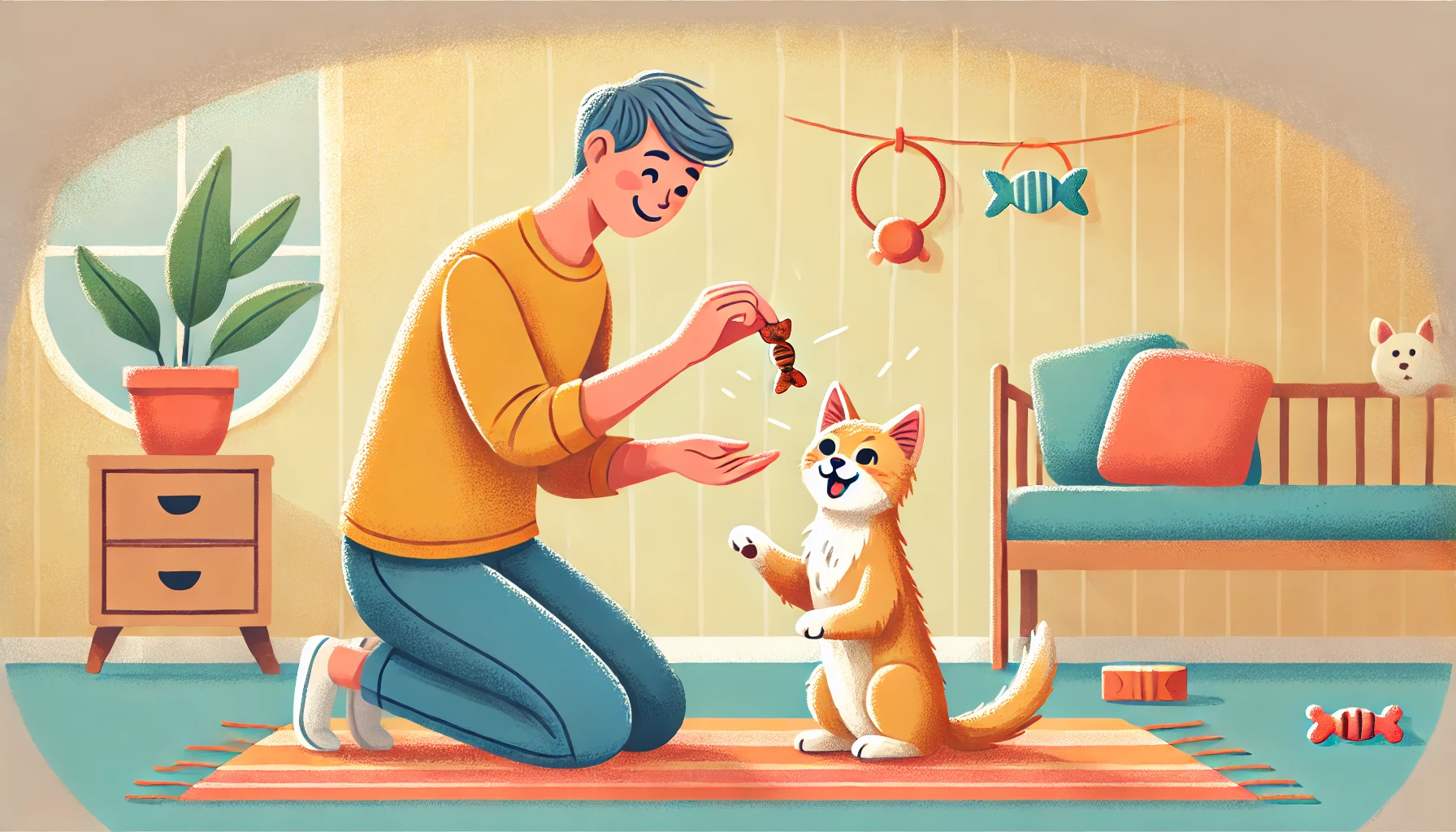
Benefits of Starting Training Early
Early-stage kitten training is highly effective.
It not only teaches commands but also helps build a strong relationship between you and your kitten.
Here are some key benefits:
- Better Behavior: Kittens that receive early training are less likely to develop undesirable behaviors, such as biting or scratching.
- Strong Bond: Training helps your kitten bond strongly with you through the establishment of trust and communication.
- Social Confidence: Early training increases the chances that kittens will grow more comfortable around other pets and people, reducing the risk of anxiety or aggression later in life.
- Lifelong Skills: The behaviors a kitten learns through training will carry into adulthood, making them easier to handle as they age.
Generally speaking, early kitten training lays the foundation for a well-behaved, confident, happy cat.
It makes life much easier for you as a pet owner and ensures a complete, harmonious life with your kitten.
Starting early with kitten training helps establish good habits that last a lifetime.

Socializing Your Kitten: Building Positive Habits
Socialization of the kitten is one of the most important aspects of kitten training, influencing how your cat will behave with humans and other animals.
Well-socialized kittens tend to be friendly, confident, and adaptable to new environments.
Socialization involves not only exposing your kitten to different people and animals but also introducing them to a variety of sights, sounds, and experiences.
Here’s how you can appropriately socialize your kitten.

Socializing Kittens to New Environments
Introducing kittens to different environments is a key phase of socialization.
This reduces anxiety and fearful behavior as they grow.
Start by taking your kitten through different rooms in your house.
Once they become comfortable, you can gradually introduce them to controlled environments such as a friend’s house or even a pet-friendly park.
- Home exploration: Allow your kitten to wander freely and explore different areas of your house under supervision to help them become more comfortable in unfamiliar spaces.
- New Textures and Surfaces: Expose your kitten to various textures, such as carpet, hardwood, and tiles, to reduce sensitivity to unusual surfaces later in life.
- Outdoor Exposure: While safety is important, short, controlled outings like in an enclosed garden or on a leash can help your kitten get used to new surroundings and smells.
Gradually expanding your kitten’s world will minimize the chances of stress and fear when they encounter new situations as an adult cat.

Socializing with Humans and Other Pets
Socialization is essential in helping your kitten build positive associations with people and animals.
Without proper socialization, kittens can become fearful or aggressive.
Your kitten needs exposure to a range of people, including children, adults, and seniors, as well as other pets in your household.
Always supervise these interactions to ensure they remain calm and positive.
- Meeting new people: Allow your kitten to interact with different people in short, easy sessions. Encourage visitors to handle your kitten gently and offer treats to help the kitten form positive associations with humans.
- Interaction with other pets: If you have other pets, introduce them to your kitten gradually to ensure both your kitten and older pets feel safe. This will eventually create a harmonious household.
- Handling and grooming: Get your kitten used to being handled, including grooming and veterinary-style checks. This reduces stress during vet visits or grooming sessions.
Proper socialization helps your kitten grow into a confident, friendly, and well-adjusted cat.
The earlier you start, the more successful these interactions will be in shaping your kitten’s behavior for life.

Preventing Fearful and Aggressive Behaviors
Socialization not only promotes good behaviors but also prevents fearful or aggressive tendencies.
Kittens that are exposed to new people and experiences are less likely to develop fearful responses to unfamiliar situations.
Using positive reinforcement—such as treats, praise, and toys—will encourage good behavior during introductions.
- Positive Reinforcement: Always reward your kitten for calm and friendly behavior. Never punish fearful reactions, as this can heighten anxiety.
- Gradual exposure: Introduce new experiences and people gradually so your kitten won’t feel overwhelmed. Rushing can lead to fear-based aggression.
- Body language: Pay attention to your kitten’s body language. If they seem afraid or nervous, allow them to retreat and recharge.
With patience and continued socialization, your kitten will develop the ability to handle new experiences with confidence and curiosity.
This can prevent behavioral problems in adulthood.
Socializing your kitten helps them adapt to new environments and people, ensuring a friendly and confident adult cat.

Key Commands to Train Your Kitten
Kitten training forms the foundation of effective kitten care.
Besides helping regulate your kitten’s behavior, command training is also an excellent way to bond with your pet.
By ensuring rewards are positive and consistent, you can teach your kitten to remember important commands with ease.
Here are some major kitten training commands to start with:

Teaching Kittens to Come to Their Name
One of the first things to teach your kitten is to recognize and respond to their name.
This allows you to get their attention and call them when needed.
To do this, say your kitten’s name in a calm, cheerful voice, and immediately reward them with a treat or praise when they respond.
- Repeat this process: Use your kitten’s name during playtime, feeding, or while petting them. This helps them associate the sound of their name with positive experiences.
- Pair with rewards: When your kitten looks toward you after hearing their name, reinforce that behavior with a treat or affectionate praise.
- Be patient: If your kitten doesn’t respond immediately, be patient. They may still be learning, and it may take time for them to consistently respond to their name.
Once your kitten consistently responds to their name, you will find it easier to manage them in various situations, both indoors and outdoors.

Simple Commands: Sit, Stay, and Come
Training your kitten to follow basic commands like ‘sit,’ ‘stay,’ and ‘come’ helps regulate their behavior in various situations.
While these commands are often associated with dogs, kittens can also learn them with the right approach.
- Teaching ‘sit’: Hold a treat above your kitten’s head and move it backward. As they naturally sit to follow the treat, say the command ‘sit’ and reward them.
- Teaching ‘stay’: Once your kitten has learned ‘sit,’ you can gradually teach them ‘stay.’ After giving the ‘sit’ command, use a hand gesture and say ‘stay,’ rewarding them when they remain in place for a few seconds. Increase the duration over time.
- Teaching ‘come’: Use a happy voice and a treat to call your kitten. As they approach, use the word ‘come,’ and reward them when they reach you.
These basic commands allow you to better control your kitten’s movements and help keep them safe in various situations.
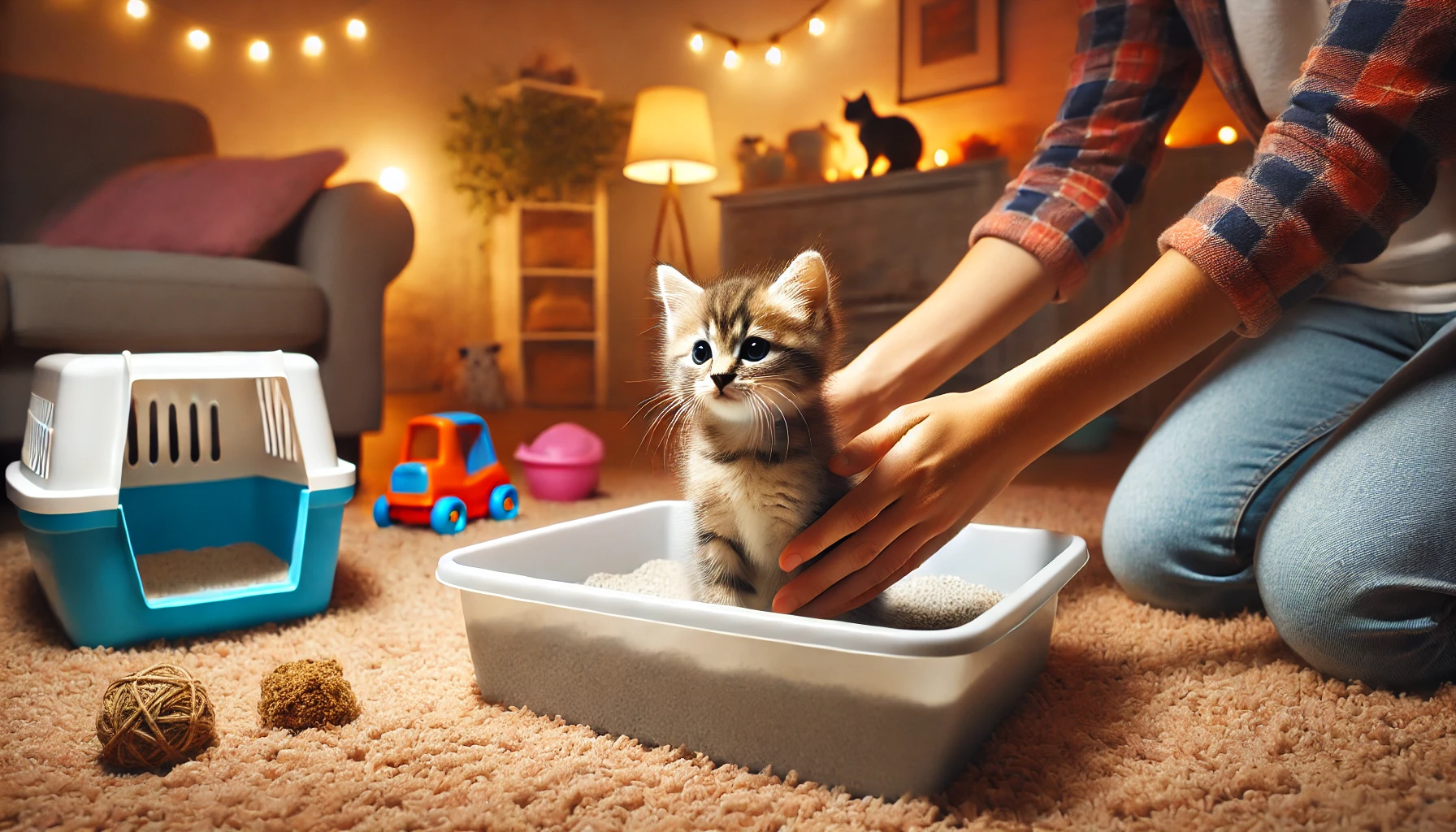
Housebreaking Your Kitten
One of the most important aspects of kitten training is litter box training.
Luckily, kittens have a natural instinct to bury their waste, making this process easier.
To successfully train your kitten, follow these steps:
- Choose the right litter box: Select a box with low sides, making it easy for your kitten to climb in and out.
- Show them where it is: Place your kitten in the litter box after meals and naps to help them associate the space with bathroom breaks.
- Keep it clean: Kittens prefer a clean environment, so scoop the litter box regularly to encourage consistent use.
- Positive reinforcement: Whenever your kitten uses the litter box, offer praise or a treat to reinforce the behavior.
With consistency and patience, most kittens learn to use the litter box quickly, minimizing accidents in the home.

Limit Setting and Redirecting Undesirable Behavior
Establishing limits and correcting undesirable behaviors are crucial parts of raising a well-behaved kitten.
While kittens are naturally playful, they may scratch furniture, bite during play, or jump on counters.
- Redirect bad behavior: If your kitten scratches furniture, redirect them to a scratching post. If they bite during play, stop the session to show them that biting ends the fun.
- Use deterrents: Safe deterrents like double-sided tape on furniture or citrus sprays can discourage unwanted scratching or climbing.
- Consistency is key: Be consistent with setting boundaries and responding to bad behavior. Mixed signals can confuse your kitten and make it harder for them to learn appropriate behavior.
By setting limits and correcting bad behavior early, your kitten will learn the rules and avoid destructive habits as they grow into adulthood.
Teaching basic commands helps control your kitten’s behavior and keeps them safe.
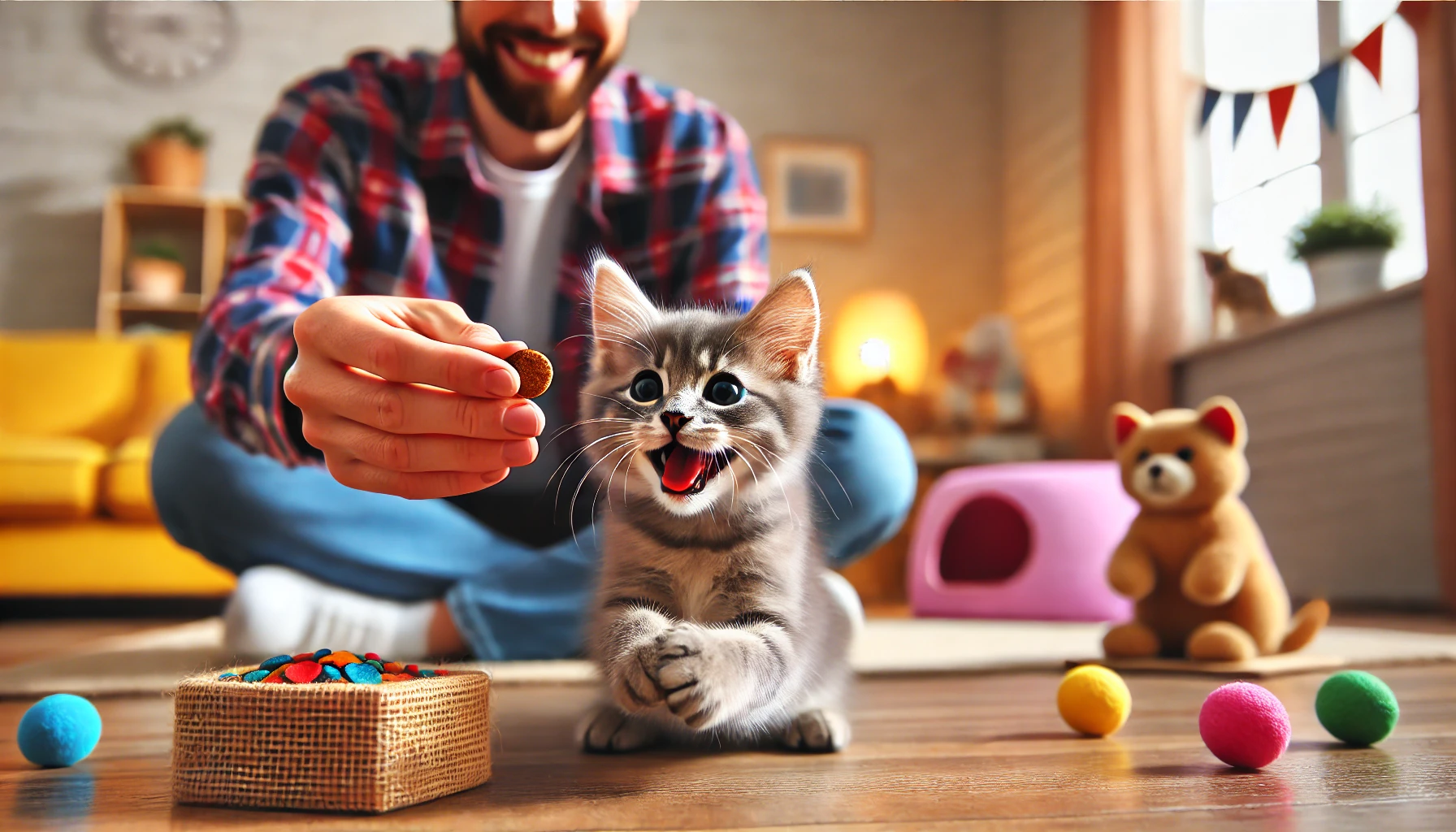
Positive Reinforcement Training in Kittens
Positive reinforcement is one of the most effective approaches for kitten training.
Instead of punishing bad behavior, it rewards good behavior, encouraging your kitten to repeat the actions you want them to do.
This method reinforces the bond between you and your kitten, creating a stress-free learning experience.
Kittens respond well to positive reinforcement because it creates a positive association with their behavior, making them more likely to repeat it in the future.
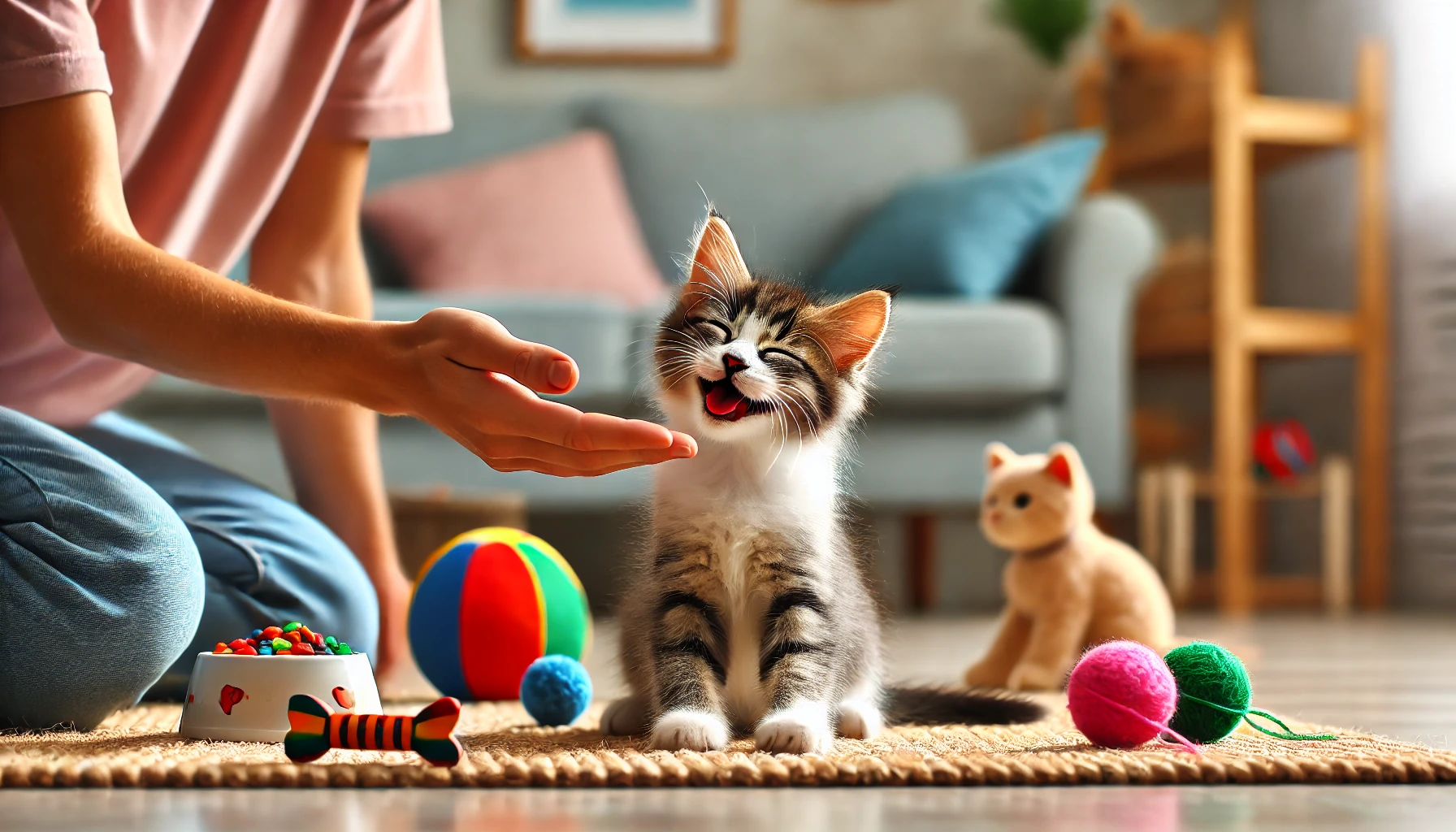
Rewards and Praise in Training
Rewards and praise are the foundation of positive reinforcement training.
Each time your kitten performs the desired behavior, immediately reward them with something they love, such as treats, affection, or playtime.
The immediate reward helps your kitten connect the action with a positive result, making them eager to perform the behavior again.
- Timing is everything: Give praise and rewards immediately after the desired behavior so your kitten can associate the reward with the action.
- Consistency: Rewards should be consistent to help your kitten know what to expect when they do something right. Inconsistent rewards can confuse them and slow down the learning process.
- Types of rewards: While treats are the most common rewards, verbal praise and petting can be just as effective. Use a variety of rewards to make training fun and engaging.
By properly rewarding and praising your kitten, you can make the training experience enjoyable for both of you.

Types of Treats and Toys for Positive Reinforcement
The treats and toys used for positive reinforcement should motivate your kitten during training.
Since kittens have short attention spans, offering rewards that capture their interest is essential.
High-value treats, like small pieces of cooked chicken or kitten-specific treats, can be especially effective.
- Healthy treats: Choose healthy treats specifically designed for kittens. Avoid giving them human food, which can sometimes be harmful.
- Play toys: For very playful kittens, interactive toys like wand toys or balls can be used instead of food treats. These toys can be effective rewards during training sessions.
- Use judiciously: While treats are effective for encouraging good behavior, portion control is important to avoid overfeeding.
By combining treats and toys, you can keep your kitten engaged and motivated, increasing the likelihood of success in kitten training.
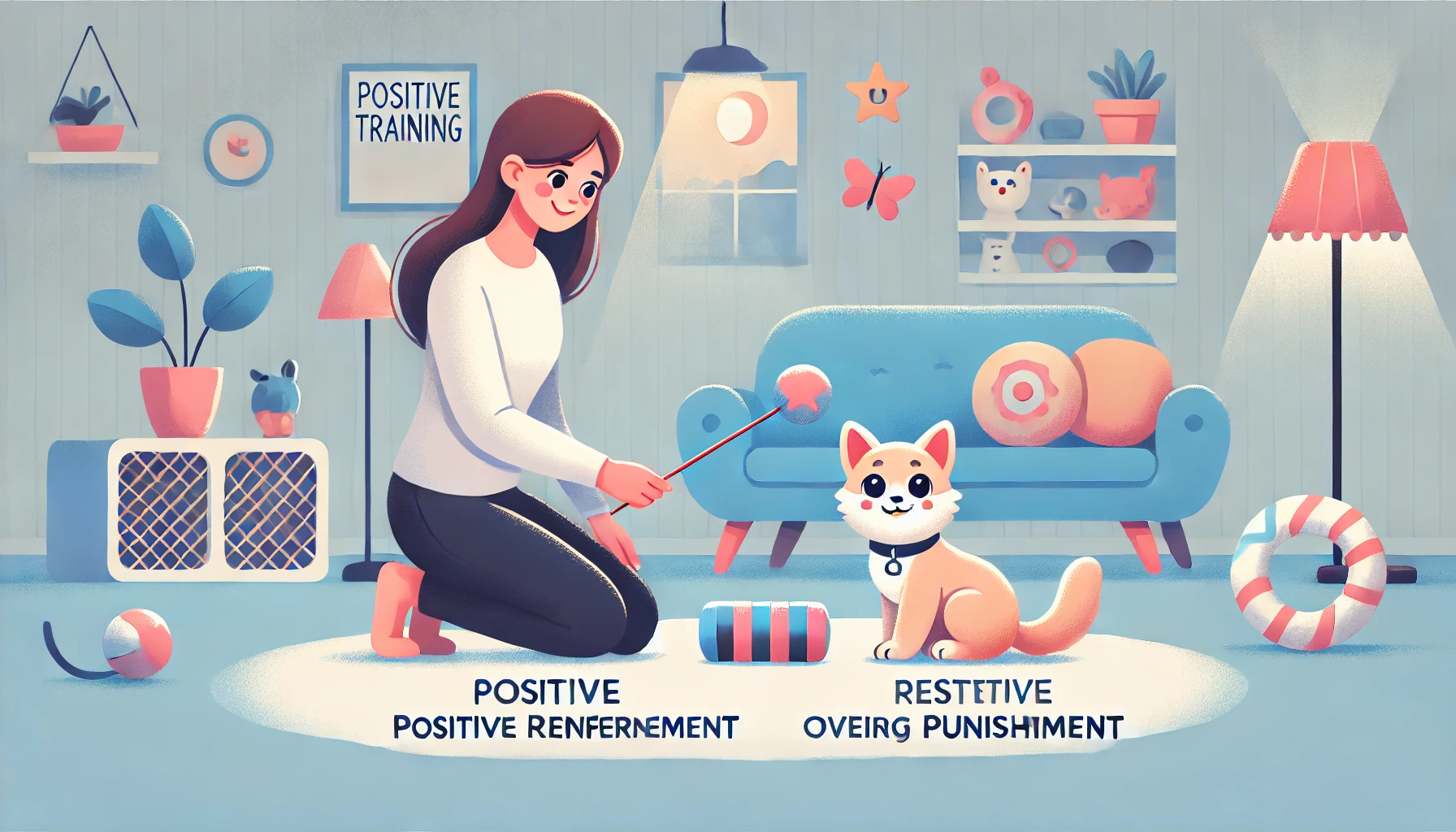
How to Avoid Punishment and Negative Reinforcement
It’s common to want to punish a misbehaving kitten, but negative reinforcement often leads to anxiety and fear rather than correcting the behavior.
Instead of punishing bad behavior, focus on redirecting your kitten’s actions and reinforcing good behavior.
Yelling or physically punishing your kitten can damage your bond and make them fearful.
- Redirect bad behavior: If your kitten is misbehaving, calmly redirect them to a more appropriate activity. For example, if they are scratching the furniture, guide them to a scratching post instead.
- Ignore minor bad behavior: Sometimes, ignoring unwanted behavior can be effective. Kittens often seek attention, and withholding it can discourage them from repeating the behavior.
- Patience is key: Training a kitten takes time, so patience is essential. Consistent positive reinforcement will lead to better results over time.
Kittens learn faster through positive reinforcement rather than punishment for mistakes.
Create a supportive environment where your kitten can grow without fear, learning through encouragement and rewards.
Positive reinforcement strengthens your bond with your kitten and encourages desired behaviors.

Common Kitten Training Challenges and How to Overcome Them
Kitten training is never easy, but it is always rewarding.
Kittens are naturally curious and energetic, which can make training challenging at times.
Recognizing common kitten training issues will help you know how to prevent or fix them effectively.
Below are some common problems encountered during kitten training and strategies to overcome them.
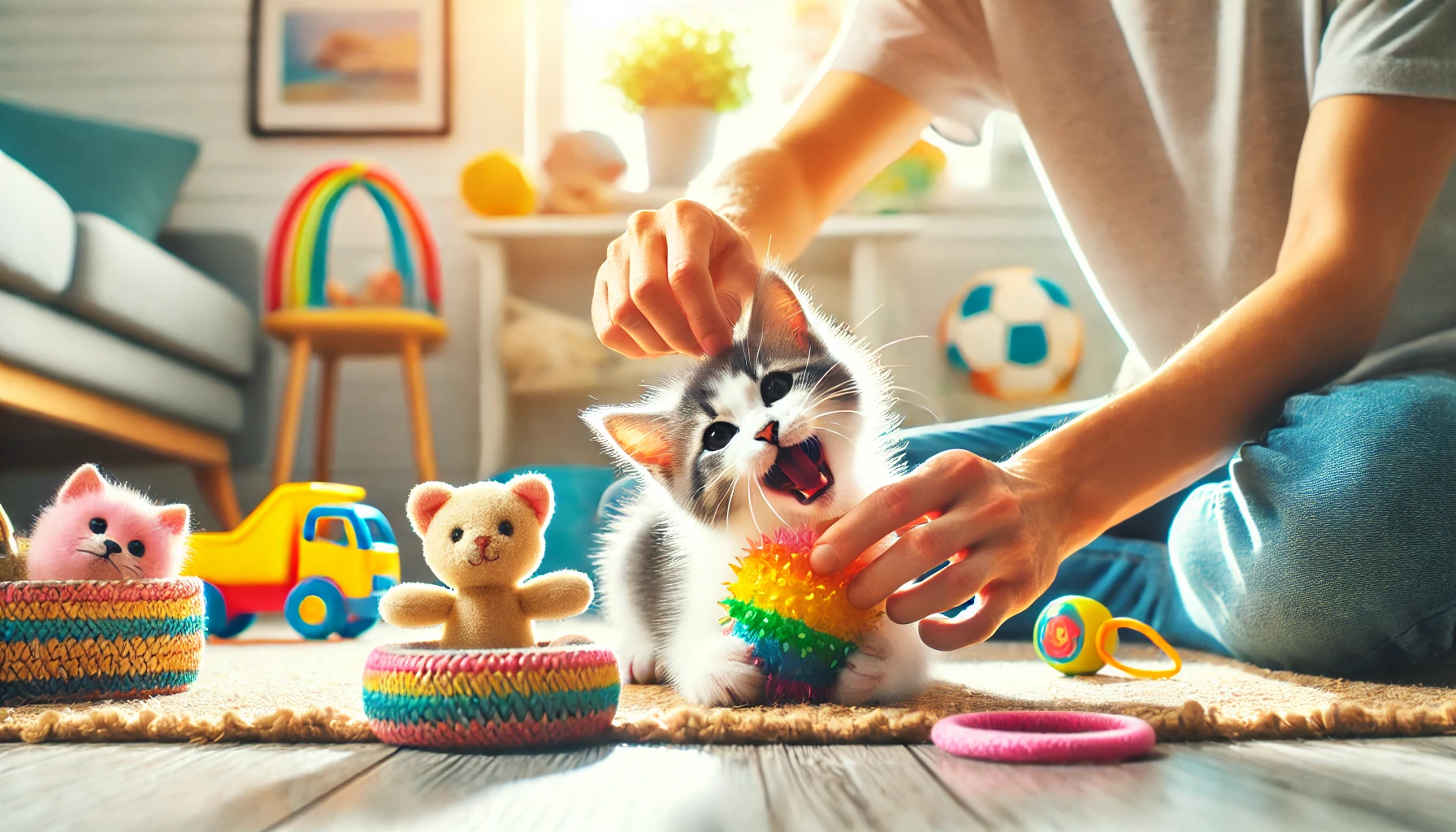
Handling Biting and Scratching While Playing
Biting and scratching are natural behaviors for kittens.
While it may seem playful, it’s important to curb these habits early on, as biting and scratching can become aggressive behaviors if not properly managed.
As predatory animals, cats instinctively manifest these behaviors through play.
- Redirect the behavior: The moment your kitten begins to bite or scratch, stop playing immediately. Redirect their attention to a toy—such as a wand or ball—to teach them that toys are for biting, not your hands.
- Don’t play with your hands: Always use toys during playtime to avoid encouraging your kitten to bite or scratch you.
- Teach gentle play: If your kitten is playing too rough, gently pull away and stop the game. Over time, they will learn that rough play leads to the end of fun.
By consistently redirecting your kitten’s biting and scratching, you can teach them to play gently without harming others.

Dealing with Litter Box Issues
Litter box training is usually straightforward, but some kittens may struggle with using the litter box consistently.
Litter box issues can be frustrating for kitten owners, but these problems are often linked to the kitten’s environment or health.
- Check the location of the litter box: Make sure the litter box is in a quiet, accessible area. If it’s too noisy or in a high-traffic area, your kitten may feel uncomfortable using it.
- Keep the box clean: Kittens prefer a clean litter box. Scoop the litter daily and change it regularly to encourage proper use.
- Try different types of litter: Some kittens may dislike certain types of litter. If your kitten is avoiding the box, try experimenting with different kinds of litter to see which one they prefer.
- See a vet if necessary: If your kitten continues to avoid the litter box despite trying these remedies, it may be a health issue. A visit to the veterinarian can rule out any medical problems.
Addressing litter box problems early will help your kitten develop good habits and reduce accidents in the future.

Solutions for Overactive or Anxious Kittens
Some kittens are hyperactive or anxious, making training more difficult.
Overactive kittens may become destructive, while anxious kittens may be fearful of new experiences and people.
- Provide enough playtime: Overly active kittens need an outlet for their energy. Engage them in interactive play with toys like feather wands or laser pointers to help them burn off excess energy.
- Provide a secure environment: Create a quiet, comfortable space where your kitten can retreat when they feel overwhelmed. This helps reduce anxiety and allows them to feel safe.
- Gradual introduction to new experiences: Nervous kittens need to be introduced to new people and environments gradually. Slow exposure helps them adjust without feeling overwhelmed.
- Use calming aids if needed: If your kitten remains anxious, try using calming aids like pheromone diffusers or calming collars to help them relax.
With patience and understanding, an overactive or anxious kitten can be made to feel more at ease, making training easier and more effective.
Understanding common training challenges helps you address issues early and effectively.

Kitten Training Mastery: A Step to a Happy and Well-Behaved Companion
Kitten training lays the foundation for the future behavior and personality of your cat.
If done properly, it can be an enriching experience for both you and your kitten.
By utilizing positive reinforcement, establishing clear boundaries, and understanding your kitten’s needs, you can raise a self-assured and well-adjusted pet.
Let’s revisit the key points covered in this guide to kitten training.

Key Points in Kitten Training
Training a kitten involves teaching basic commands, socializing them to new experiences, and addressing common behavioral issues.
Throughout the process, patience, observation, and consistency are crucial for achieving the desired results.
Some of the core components of kitten training include:
- Positive reinforcement: Rewarding good behavior with treats, praise, or playtime strengthens the bond between you and your kitten, encouraging further positive behavior.
- Socialization: Exposing your kitten to different environments, people, and animals helps them grow into a confident and secure adult cat.
- Basic commands: Teaching commands like ‘sit,’ ‘stay,’ and ‘come’ allows you to better manage situations and keep your kitten safe.
- House training: Proper hygiene is essential, and training your kitten to use the litter box is an important part of their development.
- Setting boundaries: Discouraging undesirable behaviors such as biting, scratching, or destructive actions ensures your kitten learns acceptable behavior early on.
These components provide the foundation for successful kitten training, helping your kitten become happy, disciplined, and well-adjusted.

Overcoming Kitten Training Challenges
While rewarding, kitten training can present unique challenges.
Addressing these issues early prevents them from becoming long-term problems.
Whether it’s biting, scratching, litter box issues, or an overactive kitten, the following strategies can help overcome common challenges:
- Redirecting biting and scratching to appropriate toys to prevent aggressive behavior.
- Maintaining a clean, accessible litter box to encourage proper use.
- Providing adequate playtime and creating a safe environment for anxious or hyperactive kittens.
- Introducing new experiences gradually, giving your kitten time to adjust without feeling overwhelmed.
By understanding these challenges and applying effective solutions, you’ll be better equipped to train your kitten successfully.

Building a Lifelong Bond
Kitten training isn’t just about teaching commands or discouraging bad behavior; it’s about building a lasting bond with your pet.
The trust, communication, and affection developed during training lay the groundwork for a strong relationship with your cat.
As your kitten grows, the skills they’ve learned will help them navigate life with confidence, making them a wonderful companion for years to come.
Remember, successful kitten training requires consistency, patience, and understanding.
By investing time and effort into your kitten’s early development, you’ll raise a well-behaved, confident cat that you’ll enjoy having in your home.
Kitten training is an investment in your future relationship with a well-behaved, confident companion.

FAQs About Kitten Training
Below are some of the most frequently asked questions about kitten training, along with precise answers to help you raise a well-behaved and happy kitten.
When should I start training my kitten?
The ideal time to start kitten training is at 8 weeks of age.
At this stage, kittens are highly receptive to learning and can quickly pick up good behaviors.
How long does it take to train a kitten?
Training times vary for each kitten and behavior.
Simple behaviors can usually be learned in a few weeks with consistent positive reinforcement, but ongoing practice helps reinforce these lessons.
What if my kitten doesn’t listen to training?
If your kitten isn’t responding, try varying the rewards, be patient, and stay consistent.
Shorten the training sessions and introduce different activities to keep them engaged and interested.
How do I stop my kitten from biting and scratching?
Redirect playful biting and scratching to appropriate toys.
Avoid using your hands or feet as toys, and consistently reinforce good behavior to teach your kitten to stop unwanted nipping and scratching.
How do I litter train my kitten effectively?
Place your kitten in the litter box after meals or naps.
Keep the box clean and accessible, and reward your kitten with treats or praise when they use it correctly.
What should I do if my kitten is too hyperactive?
Engage your hyperactive kitten with extended interactive play sessions using toys like feather wands or laser pointers to help them burn off excess energy.
How do I socialize my kitten with other pets?
Introduce your kitten to other pets gradually in a quiet, controlled environment.
Reward calm behavior with treats or praise when they interact positively with other animals.
Can kittens learn commands like dogs?
Yes, kittens can learn basic commands like ‘sit,’ ‘stay,’ and ‘come.’ Consistent training and positive reinforcement will help them respond to commands, though they may take longer to learn than dogs.
What are the best rewards for training a kitten?
High-value treats like kitten-specific snacks or small pieces of cooked chicken work best.
You can also use praise and playtime as rewards during training sessions.





